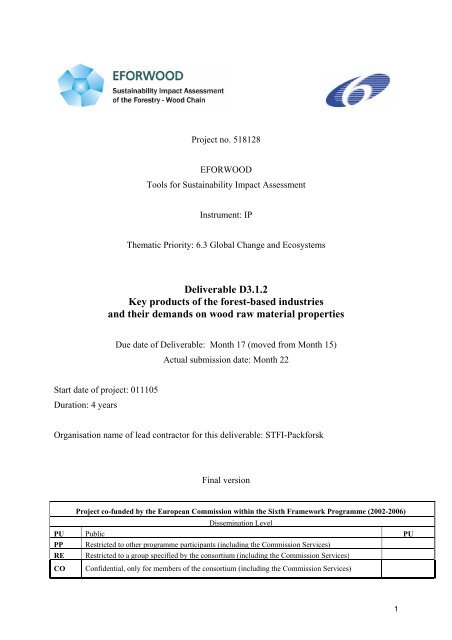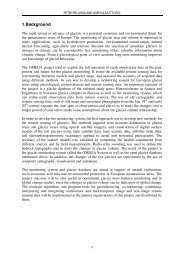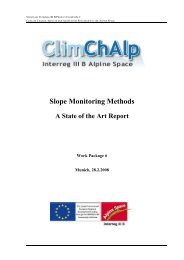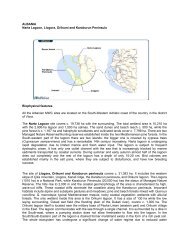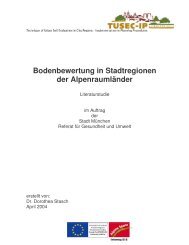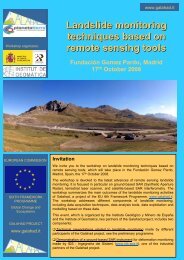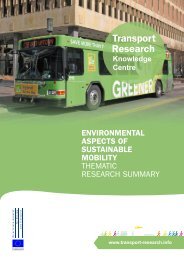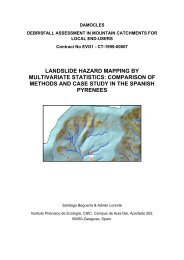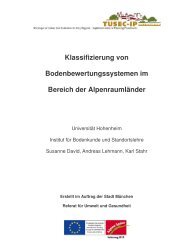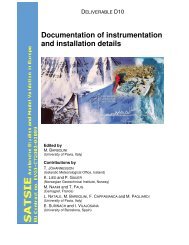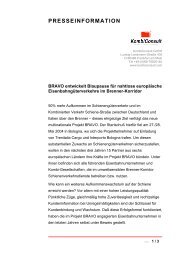Deliverable D3.1.2 Key products of the forest-based industries and ...
Deliverable D3.1.2 Key products of the forest-based industries and ...
Deliverable D3.1.2 Key products of the forest-based industries and ...
Create successful ePaper yourself
Turn your PDF publications into a flip-book with our unique Google optimized e-Paper software.
Project no. 518128EFORWOODTools for Sustainability Impact AssessmentInstrument: IPThematic Priority: 6.3 Global Change <strong>and</strong> Ecosystems<strong>Deliverable</strong> <strong>D3.1.2</strong><strong>Key</strong> <strong>products</strong> <strong>of</strong> <strong>the</strong> <strong>forest</strong>-<strong>based</strong> <strong>industries</strong><strong>and</strong> <strong>the</strong>ir dem<strong>and</strong>s on wood raw material propertiesDue date <strong>of</strong> <strong>Deliverable</strong>: Month 17 (moved from Month 15)Actual submission date: Month 22Start date <strong>of</strong> project: 011105Duration: 4 yearsOrganisation name <strong>of</strong> lead contractor for this deliverable: STFI-PackforskFinal versionProject co-funded by <strong>the</strong> European Commission within <strong>the</strong> Sixth Framework Programme (2002-2006)Dissemination LevelPU Public PUPP Restricted to o<strong>the</strong>r programme participants (including <strong>the</strong> Commission Services)RE Restricted to a group specified by <strong>the</strong> consortium (including <strong>the</strong> Commission Services)CO Confidential, only for members <strong>of</strong> <strong>the</strong> consortium (including <strong>the</strong> Commission Services)1
<strong>Key</strong> <strong>products</strong> <strong>of</strong> <strong>the</strong> <strong>forest</strong>-<strong>based</strong> <strong>industries</strong><strong>and</strong> <strong>the</strong>ir dem<strong>and</strong>s on wood raw material propertiesPartners involved <strong>and</strong> acknowledgementThis report, deliverable <strong>D3.1.2</strong>, has been produced within <strong>the</strong> EFORWOOD workpackage 3.1 “QualityAssessment <strong>and</strong> Allocation”. The responsible organization has been STFI-Packforsk.Editor <strong>of</strong> <strong>the</strong> report was Sven-Ol<strong>of</strong> Lundqvist, STFI-Packforsk, who was also responsible for <strong>the</strong> partrelated to fibres, pulp <strong>and</strong> paper. Barry Gardiner, Forest Research, was responsible for <strong>the</strong> partsrelated to solid wood/wood-<strong>based</strong> panels <strong>and</strong> bio-energy.O<strong>the</strong>r contributing researchers are: Andy Hall (Forest Research), Martin Johansson (STFI-Packforsk),<strong>and</strong> Franka Brüchert (Baden-Württemberg Forest Research Institute)The editor wishes to acknowledge <strong>the</strong> Swedish-Finnish research programme “Wood Material Science<strong>and</strong> Engineering” <strong>and</strong> <strong>the</strong> funding parties <strong>of</strong> <strong>the</strong> Innovood project, from which parts <strong>of</strong> <strong>the</strong> backgroundmaterial regarding raw material dem<strong>and</strong>s <strong>of</strong> paper <strong>products</strong> have been obtained.Thanks are also due to experts in <strong>the</strong> paper industry <strong>and</strong> at STFI-Packforsk who have contributed withvaluable input.2
<strong>Key</strong> <strong>products</strong> <strong>of</strong> <strong>the</strong> <strong>forest</strong>-<strong>based</strong> <strong>industries</strong><strong>and</strong> <strong>the</strong>ir dem<strong>and</strong>s on wood raw material propertiesTable <strong>of</strong> contentsPageAcknowledgement 21. Summary 42. Introduction 42.1 Objective 42.2 <strong>Key</strong> <strong>products</strong> 42.3 <strong>Key</strong> properties 52.4 Quantitative <strong>and</strong> qualitative dem<strong>and</strong>s 53. Fibre chains 73.1 <strong>Key</strong> <strong>products</strong> 73.2 <strong>Key</strong> dem<strong>and</strong>s on wood <strong>and</strong> fibres 73.3 CPA codes 164. Solid wood <strong>and</strong> wood-<strong>based</strong> <strong>products</strong> 184.1 <strong>Key</strong> <strong>products</strong> 184.2 <strong>Key</strong> dem<strong>and</strong>s on solid wood 184.3 <strong>Key</strong> dem<strong>and</strong>s on logs 205. Bio-energy chains 285.1 <strong>Key</strong> <strong>products</strong> 285.2 <strong>Key</strong> dem<strong>and</strong>s on manufactured <strong>products</strong> in bio-energy chain 296. Quality-<strong>based</strong> allocation <strong>of</strong> wood raw materials to key <strong>products</strong><strong>and</strong> analysis <strong>of</strong> sustainability effects323
<strong>Key</strong> <strong>products</strong> <strong>of</strong> <strong>the</strong> <strong>forest</strong>-<strong>based</strong> <strong>industries</strong><strong>and</strong> <strong>the</strong>ir dem<strong>and</strong>s on wood raw material properties1. SummaryThe scope <strong>of</strong> this report is to express <strong>the</strong> dem<strong>and</strong>s on wood <strong>and</strong> fibres for selected <strong>products</strong> frommajor production lines in terms <strong>of</strong> raw material properties. The major production lines are divided intosolid wood chains, fibre chains <strong>and</strong> bio-energy chains. For each type <strong>of</strong> chains, sets <strong>of</strong> key producttypes have been identified.Properties <strong>of</strong> importance for <strong>the</strong>se product types have been listed. When possible, threshold valueshave been given. The plan is to revise <strong>the</strong> report later during <strong>the</strong> EFORWOOD project when moreinformation on threshold values can be introduced.In many cases, it is, however, not possible to state generally applicable threshold values, as <strong>the</strong>re arealternatives. If <strong>the</strong> available raw material is not suitable, it may be possible to investment in order tomake use <strong>of</strong> ano<strong>the</strong>r material. In particular, <strong>the</strong>se issues are very common for <strong>the</strong> fibre chains. In<strong>the</strong>se cases, <strong>the</strong> dem<strong>and</strong>s have to be expressed in more qualitative terms <strong>and</strong> <strong>the</strong> text <strong>of</strong> <strong>the</strong> report iswritten to provide a background to <strong>the</strong> preference for certain raw materials. Preferred values are onlyindicated ra<strong>the</strong>r than stated.The tables <strong>of</strong> key <strong>products</strong> have already proven to be useful, in connection with <strong>the</strong> establishment <strong>of</strong><strong>the</strong> layout <strong>of</strong> <strong>the</strong> Iberian case.2. Introduction2.1 ObjectiveThe objective <strong>of</strong> <strong>the</strong> deliverable <strong>D3.1.2</strong> within <strong>the</strong> workpackage 3.1 “Quality Assessment <strong>and</strong>Allocation” <strong>of</strong> module 3 was defined as:• To express <strong>the</strong> dem<strong>and</strong>s on wood <strong>and</strong> fibres for selected <strong>products</strong> in major production lines(solid wood to wood <strong>products</strong>, fibres to pulp <strong>and</strong> paper <strong>products</strong>, bio-energy) in terms <strong>of</strong> rawmaterial properties.To do this, it is obviously necessary to clearly define <strong>the</strong> <strong>products</strong> selected. Therefore, <strong>the</strong> deliverablehas been exp<strong>and</strong>ed to include <strong>the</strong> task <strong>of</strong>:• Defining <strong>the</strong> key <strong>products</strong> <strong>of</strong> <strong>the</strong> major production chains <strong>of</strong> <strong>forest</strong> <strong>based</strong> <strong>industries</strong> <strong>and</strong> <strong>the</strong>materials processed along each production chains.2.2 <strong>Key</strong> <strong>products</strong>The ambition has been to identify sets <strong>of</strong> key <strong>products</strong> for <strong>the</strong> major production chains, which arehereafter referred to as:• solid wood chains• fibre chains• bio-energy chains4
<strong>Key</strong> <strong>products</strong> <strong>of</strong> <strong>the</strong> <strong>forest</strong>-<strong>based</strong> <strong>industries</strong><strong>and</strong> <strong>the</strong>ir dem<strong>and</strong>s on wood raw material propertiesThe ambition has not been to list all possible <strong>products</strong> produced in all countries, but ra<strong>the</strong>r <strong>the</strong> key<strong>products</strong> or types <strong>of</strong> <strong>products</strong> <strong>of</strong> <strong>the</strong> different production chains. The ambition has been to defineproduct types covering at least 80 % <strong>of</strong> <strong>the</strong> production within Europe as a whole, so that <strong>the</strong> listedproduct types will cover at least 60-80 % <strong>of</strong> <strong>the</strong> production for <strong>the</strong> regions in which ToSIA, <strong>the</strong> Tool forSustainability Impact Assessment, is foreseen to be used within <strong>the</strong> EFORWOOD project <strong>and</strong>afterwards. Ano<strong>the</strong>r ambition has been to aggregate <strong>the</strong> types <strong>of</strong> <strong>products</strong> to a limited set which ispossible to relate to available statistics on consumption, production, import, export, etc.The selection <strong>of</strong> <strong>the</strong> key <strong>products</strong> has been performed in cooperation with experts engaged in relatedtasks within Modules 4 <strong>and</strong> 5. The starting point has been to identify <strong>the</strong> main types <strong>of</strong> converted<strong>products</strong> used by <strong>the</strong> end-user, such as books, sacks, outdoor furniture, pallets, floor systems, pellets,etc. <strong>and</strong> to follow <strong>the</strong> chains back to <strong>the</strong> raw material. For example a book (converted product in M5) isin most cases printed with <strong>of</strong>fset or digital printing on printing paper (paper product in M4), which inturn is manufactured from bleached kraft (chemical) pulp (pulp product in M4) produced fromhardwood <strong>and</strong>/or s<strong>of</strong>twood (raw material from M3) or from <strong>the</strong>rmo mechanical pulp (TMP) from sprucewood (M3) or from de-inked pulp (DIP) from paper collected in M5 <strong>and</strong> upgraded in M4.The lists <strong>of</strong> key <strong>products</strong> have also proven useful in <strong>the</strong> preparation <strong>of</strong> <strong>the</strong> regional cases. Theestablishment <strong>of</strong> <strong>the</strong> general layout <strong>of</strong> <strong>the</strong> fibre chains <strong>of</strong> <strong>the</strong> Iberian case study, which applies aconsumer perspective on <strong>the</strong> <strong>forest</strong>ry wood chain, may be used as an example. We started by lookinginto <strong>the</strong> statistics for paper consumption in Spain <strong>and</strong> Portugal. 4 product types which constitutedabout 70 % <strong>of</strong> <strong>the</strong> consumption <strong>of</strong> paper were identified. We <strong>the</strong>n concluded that most <strong>of</strong> <strong>the</strong>se<strong>products</strong> were produced from wood harvested or recycled fibres collected on <strong>the</strong> Iberian peninsula.Only one type <strong>of</strong> paper <strong>and</strong> bleached long-fibre pulp were imported in substantial volumes. Thesources <strong>of</strong> <strong>the</strong>se imports were identified <strong>and</strong> it was concluded that only <strong>forest</strong> resources in Spain <strong>and</strong>Portugal <strong>and</strong> in regions representing <strong>the</strong>se imports have to be dealt with in <strong>the</strong> study. In this way, <strong>the</strong>general layout was established.2.3 <strong>Key</strong> propertiesFor each one <strong>of</strong> <strong>the</strong>se key <strong>products</strong>, sets <strong>of</strong> key properties have been listed <strong>and</strong> property dem<strong>and</strong>shave been expressed. The key raw material properties which have to be considered have been listed<strong>and</strong> commented on below.2.4 Quantitative <strong>and</strong> qualitative dem<strong>and</strong>sSometimes it is said that a mill can operate on any available wood raw materials. This may be true forsome <strong>products</strong> with low added value or with large efforts made in <strong>the</strong> processes <strong>of</strong> <strong>the</strong> mill. Normally itis about optimization <strong>of</strong> product performance <strong>and</strong> costs, including costs for <strong>the</strong> raw material as well asfor <strong>the</strong> processing in <strong>the</strong> mill. Less suitable materials may result in lower yield <strong>and</strong> higher operationcosts. Sometimes, <strong>the</strong> properties <strong>of</strong> wood or fibres have to be tightly controlled. If <strong>the</strong> available rawmaterial is not suitable, you may have to do an investment to make <strong>the</strong> material useful or to allow use<strong>of</strong> ano<strong>the</strong>r material.5
<strong>Key</strong> <strong>products</strong> <strong>of</strong> <strong>the</strong> <strong>forest</strong>-<strong>based</strong> <strong>industries</strong><strong>and</strong> <strong>the</strong>ir dem<strong>and</strong>s on wood raw material propertiesIn some cases, it is possible to express property dem<strong>and</strong>s with specific values, for instance when <strong>the</strong>mechanical properties <strong>of</strong> wood materials for constructions have been st<strong>and</strong>ardised. Where it has beenpossible to define such threshold values <strong>the</strong>se have been included.In many cases, however, it is not possible to express <strong>the</strong> product dem<strong>and</strong>s in general terms because<strong>the</strong> same type <strong>of</strong> product may be possible to produce in production lines designed in alternative wayswhich are able to h<strong>and</strong>le materials with different properties. However, it does not imply that <strong>the</strong> rawmaterial properties in <strong>the</strong>se cases are <strong>of</strong> less importance, but that alternatives may be developed toallow <strong>the</strong> use <strong>of</strong> materials that would o<strong>the</strong>rwise be regarded as unacceptable or not economicallyfeasible. Researchers may develop <strong>and</strong> producers invest in new processing equipment to deal with<strong>the</strong> problem. The associated costs for <strong>the</strong> investment <strong>and</strong> sustainability impacts <strong>of</strong> <strong>the</strong> modifiedoperation (use <strong>of</strong> energy, chemicals, person-hours, etc.) have, <strong>of</strong> course, to be considered. Suchdevelopment may also make it possible to <strong>of</strong>fer <strong>the</strong> customer a better product or a good enoughproduct at a lower cost or price provided that proper investment is made. Use <strong>of</strong> especially suitablematerials may, on <strong>the</strong> o<strong>the</strong>r h<strong>and</strong>, increase product yield, quality, added value, customer satisfaction<strong>and</strong> reduce material use, transportation, etc. Innovations in new or improved <strong>products</strong> <strong>and</strong> processesas well as market supply <strong>and</strong> dem<strong>and</strong> will continuously change <strong>the</strong> conditions <strong>and</strong> bring newpossibilities or difficulties. Some <strong>of</strong> <strong>the</strong>se optimisations can be performed gradually to adapt to <strong>the</strong>current situation, o<strong>the</strong>rs will involve large investment <strong>and</strong> are performed stepwise after major decisionswhere it may also be an alternative to shutting down <strong>the</strong> operation.Property variations in <strong>the</strong> processed materials may, thus, to some extent be dealt with throughoptimisation <strong>and</strong> investments in <strong>the</strong> long or medium time frame <strong>and</strong> through process adjustments<strong>based</strong> on assessment <strong>and</strong> measurements <strong>and</strong> process control in <strong>the</strong> short term. Even so, it isimportant to bear in mind that product quality <strong>and</strong> production efficiency are normally improved by use<strong>of</strong> materials with uniform properties.From this insight, it has been concluded that <strong>the</strong> property dem<strong>and</strong>s in many cases can only beexpressed in a qualitative way ra<strong>the</strong>r than quantitative <strong>and</strong> general terms. An obvious observation isthat <strong>the</strong> more steps <strong>of</strong> conversion or processing that are involved in <strong>the</strong> manufacturing <strong>of</strong> a product,<strong>the</strong> more alternatives will be possible <strong>and</strong> <strong>the</strong> more difficult is it to define property dem<strong>and</strong>s on <strong>the</strong>initial wood raw material. It may be ra<strong>the</strong>r straight-forward for a board but less so for a wood-<strong>based</strong>construction element or a paper product in which <strong>the</strong> wood fibres have been totally restructured.The more <strong>the</strong> materials have been converted, <strong>the</strong> more expertise is needed to make a realisticjudgement on <strong>the</strong> property dem<strong>and</strong>s <strong>and</strong> how allocation <strong>and</strong> processing can be optimised whendealing with a specific <strong>forest</strong> resource, production facility <strong>and</strong> product. This is also to some extentreflected in <strong>the</strong> character <strong>of</strong> <strong>the</strong> chapters dealing with fibre chains, solid wood chains <strong>and</strong> bio-energychains respectively. In <strong>the</strong> chapter related to production <strong>of</strong> pulp <strong>and</strong> paper, which is more complex <strong>and</strong>also assumed to be less familiar to most readers than <strong>the</strong> o<strong>the</strong>r production chains, a brief presentation<strong>of</strong> relationships between properties <strong>of</strong> fibres <strong>and</strong> paper has been added.6
<strong>Key</strong> <strong>products</strong> <strong>of</strong> <strong>the</strong> <strong>forest</strong>-<strong>based</strong> <strong>industries</strong><strong>and</strong> <strong>the</strong>ir dem<strong>and</strong>s on wood raw material properties3. Fibre chains3.1 <strong>Key</strong> <strong>products</strong>The key <strong>products</strong> selected from <strong>the</strong> fibre chains <strong>and</strong> from what materials <strong>the</strong>y are produced arestructured in Table 1, <strong>and</strong> are divided into:• Graphic <strong>products</strong> (1a - 1d)• Packaging <strong>products</strong> (2a – 2e)• Hygiene <strong>products</strong> (3a – 3b)The list includes a total <strong>of</strong> 11 key types <strong>of</strong> converted <strong>products</strong> produced from 13 key paper types. Inmany cases <strong>the</strong> paper <strong>products</strong> are built up by mixing fibres with different properties <strong>and</strong> o<strong>the</strong>rmaterials, in order to optimize quality/functionality <strong>and</strong> cost/price. Higher cost materials or fur<strong>the</strong>rprocessing (with associated costs) may be used to produce higher quality grades, <strong>and</strong> vice versa.Some <strong>of</strong> <strong>the</strong> paper types are multi-ply materials, where <strong>the</strong> different layers serve different purposes,for instance to enhance an important property or to reduce costs. The layers are <strong>of</strong>ten produced fromdifferent types <strong>of</strong> pulps, which are processed to optimise <strong>the</strong> material as a composite.Some basic product properties are common for many <strong>of</strong> <strong>the</strong> key <strong>products</strong> <strong>of</strong> <strong>the</strong> fibre chains:printability, stiffness, runability on <strong>the</strong> paper machine, in printing presses <strong>and</strong> o<strong>the</strong>r converting, etc.The properties obtained in <strong>the</strong> paper depend both on <strong>the</strong> fibre raw materials used <strong>and</strong> <strong>the</strong> processing<strong>of</strong> <strong>the</strong> materials in <strong>the</strong> production line (equipment <strong>and</strong> conditions). As <strong>the</strong> fibres have similar influenceson several properties important for many <strong>products</strong>, <strong>the</strong>se relationships are commented on separately.3.2 <strong>Key</strong> dem<strong>and</strong>s on wood <strong>and</strong> fibresThe properties <strong>of</strong> <strong>the</strong> fibres, pulp <strong>and</strong> paper used in <strong>the</strong> different parts <strong>of</strong> <strong>the</strong> production chains arevery important for <strong>the</strong> product properties <strong>and</strong> <strong>the</strong> production efficiency. For paper <strong>products</strong>, no specificgeneral threshold values can be defined for <strong>the</strong> materials used along <strong>the</strong> production chains. Theproperties need to be suitable for <strong>the</strong> product <strong>and</strong> <strong>the</strong> process <strong>and</strong> <strong>the</strong>y also have to be uniform <strong>and</strong>predictable.When <strong>the</strong> basic functionalities <strong>of</strong> a pulp or paper product are fulfilled, <strong>the</strong> uniformity is <strong>of</strong>ten said to be<strong>the</strong> most prominent “property”. Uniformity shall in this context be understood as constant propertydistributions in time, not as homogeneous. When a printer has adapted his press to a certain paper,he wants to get paper with <strong>the</strong> same properties all <strong>the</strong> time. And this constancy should preferably startwith <strong>the</strong> wood raw material fed into <strong>the</strong> process. Some heterogeneity in fibre properties may, however,<strong>of</strong>ten be beneficial: Some long fibres in <strong>the</strong> pulp will provide good strength <strong>of</strong> <strong>the</strong> wet paper sheet on<strong>the</strong> paper machine <strong>and</strong> will improve <strong>the</strong> runability, but if <strong>the</strong>y are too many, <strong>the</strong> fibres will start to formflocks <strong>and</strong> <strong>the</strong> formation <strong>of</strong> <strong>the</strong> paper will suffer. Suitable property distributions are, thus, needed <strong>and</strong><strong>the</strong>y should be reasonably constant in time. If suitable distributions can not be obtained from a singlepulp, it is mixed with pulps or materials to match <strong>the</strong> specifications. A typical example <strong>of</strong> this is <strong>the</strong>addition in many <strong>products</strong> <strong>of</strong> some “reinforcement pulp”, longfibre kraft pulp, to increase strength.7
Table 1: <strong>Key</strong> <strong>products</strong> <strong>of</strong> fibre chains <strong>and</strong> fibre <strong>based</strong> materials used along each production chain<strong>Key</strong> <strong>products</strong> <strong>of</strong> <strong>the</strong> <strong>forest</strong>-<strong>based</strong> <strong>industries</strong><strong>and</strong> <strong>the</strong>ir dem<strong>and</strong>s on wood raw material propertiesChain Converted product (M5) Paper (M4) Pulp (M4) Fibre raw material (M3)1a1b1c1dGraphic <strong>products</strong> Suitable fibres from …NewspapersNewsprintDIP (de-inked pulp)Recycling (M5+M4)(cold-set web <strong>of</strong>fset)TMPSpruceCatalogues, journals <strong>and</strong> magazines(gravure printing)Books, brochures <strong>and</strong> folders(<strong>of</strong>fset <strong>and</strong> digital printing)Fine/Office paper(no conversion)Magazine paperPrinting paperWoodfree paperTMP, CTMP, SGW (stone groundw.)Kraft pulp, bleachedKraft pulp, bleachedTMP, CTMPDIP (de-inked pulp)Kraft pulp, bleachedOffice wasteSpruce, aspenS<strong>of</strong>twoodHardwood, s<strong>of</strong>twoodSpruce, aspenRecycling (M5+M4)Hardwood, s<strong>of</strong>twood,Recycling (M5+M4)2a2b2cPackaging <strong>products</strong>Corrugated boxesCarton boards containers(flexographic/<strong>of</strong>fset/digital printing)Liquid carton board containers(flexographic/<strong>of</strong>fset/digital printing)Kraftliner Kraft pulp, unbleached/bleached S<strong>of</strong>twood, hardwoodTestliner OCC (Old Corrugated Containers) Recycling (M5+M4)FlutingDIP(de-inked pulp)NSSCRecycling (M5+M4)HardwoodPaper boardKraft pulp, bleached/unbleached S<strong>of</strong>twood, hardwood(mainly)Mid-layer: TMP, CTMP, DIP Spruce, recyclingLiquid carton boardKraft pulp, bleached/unbleached S<strong>of</strong>twood, hardwood(mainly) Mid-layer: CTMP Spruce2d Sacks Sack paper layers (mainly) Kraft pulp, bleached/unbleached S<strong>of</strong>twood2e Bags Kraft paper Kraft pulp, bleached/unbleached Hardwood, s<strong>of</strong>twood3aHygiene <strong>products</strong>Hygiene - Household Tissue paperOffice wasteRecycling (M5+M4)3b Sanitary goods AbsorbantsKraft pulp, bleachedKraft pulp, bleachedCTMPHardwood, s<strong>of</strong>twoodS<strong>of</strong>twoodS<strong>of</strong>twood8
<strong>Key</strong> <strong>products</strong> <strong>of</strong> <strong>the</strong> <strong>forest</strong>-<strong>based</strong> <strong>industries</strong><strong>and</strong> <strong>the</strong>ir dem<strong>and</strong>s on wood raw material propertiesBasic properties common for several paper <strong>products</strong>Paper is basically a network <strong>of</strong> fibres. The properties <strong>of</strong> a paper are determined by <strong>the</strong> properties <strong>of</strong><strong>the</strong> fibres, <strong>the</strong> structure <strong>of</strong> <strong>the</strong> network <strong>and</strong> <strong>the</strong> character <strong>of</strong> <strong>the</strong> bonds between <strong>the</strong> fibres. It is alsoinfluenced by materials added to <strong>the</strong> network to improve specific properties or to reduce costs, suchas starch <strong>and</strong> fillers. Very <strong>of</strong>ten, paper is produced from mixtures <strong>of</strong> pulps <strong>and</strong> o<strong>the</strong>r materials <strong>and</strong><strong>of</strong>ten in multiple layers, where each layer shall have its specific properties to contribute to <strong>the</strong>properties <strong>of</strong> <strong>the</strong> engineered composite <strong>and</strong> to reduce costs. A good example <strong>of</strong> this is multi-ply paperboard, which has to be stiff (shall not bend easily). The solution is to use two surface layers with hightensile stiffness <strong>and</strong> to separate <strong>the</strong>se surfaces with material <strong>of</strong> lower density <strong>and</strong> cost. The materials<strong>of</strong> <strong>the</strong> different layers are selected <strong>and</strong> processed to fulfil <strong>the</strong> requirements for runability <strong>and</strong> o<strong>the</strong>rproperties at <strong>the</strong> lowest possible cost.For all types <strong>of</strong> paper, certain strength properties have to be fulfilled for acceptable runability on <strong>the</strong>paper machine, in printing presses <strong>and</strong> o<strong>the</strong>r converting equipments <strong>and</strong> for <strong>the</strong> expected functionalityby <strong>the</strong> end user. Different levels <strong>of</strong> strength <strong>and</strong> types <strong>of</strong> mechanical <strong>and</strong> fracture properties (tensile,tear, delamination, puncture, etc.) are relevant depending on <strong>the</strong> final product. The stiffness <strong>and</strong>dimensional stability is important for many <strong>products</strong>. Surfaces need to stay flat <strong>and</strong> packagingmaterials need to remain rigid, even with reasonable humidity variations, while o<strong>the</strong>r <strong>products</strong> need tobe somewhat elastic to absorb sudden loads.The structure <strong>of</strong> <strong>the</strong> fibre network is also important <strong>and</strong> particularly its evenness/homogeneity. Onlylimited variations in sheet grammage, g/m 2 , (formation) <strong>and</strong> thickness or density are acceptable.O<strong>the</strong>rwise <strong>the</strong> paper can not be optimally used. Local deviations may also initiate breaks. High bulk(low sheet density) is sometimes appreciated to save material (for instance in <strong>the</strong> mid-layer <strong>of</strong> paperboard in <strong>the</strong> example above) <strong>and</strong> for porosity. Porosity <strong>and</strong> surface properties <strong>of</strong> <strong>the</strong> paper are alsoimportant, for instance for printing, absorption, coating, lamination <strong>and</strong> tactile properties.Nowadays, most types <strong>of</strong> paper <strong>products</strong> carry printed information, which brings dem<strong>and</strong>s not only onsurface properties as mentioned above but also on optical properties like light scattering, uniformappearance, etc.Important properties <strong>of</strong> fibres in relation to paper propertiesThe dimensions <strong>of</strong> <strong>the</strong> fibres (length, width <strong>and</strong> wall thickness) are important in <strong>the</strong>mselves, especially<strong>the</strong> fibre length <strong>and</strong> fibre wall thickness. A number <strong>of</strong> relationships between fibre length, width <strong>and</strong> wallthickness are also very important in papermaking <strong>and</strong> for <strong>the</strong> properties <strong>of</strong> <strong>the</strong> <strong>products</strong>. Below, someimportant fibre properties are listed. Their level <strong>of</strong> importance depends on <strong>the</strong> product <strong>and</strong> processesused:• Fibre length• Fibre wall thickness• Fibre coarseness (g/km fibre), defined by fibre width <strong>and</strong> wall thickness (<strong>and</strong> process yield)• Number <strong>of</strong> fibres/g, defined by fibre length, width <strong>and</strong> wall thickness (<strong>and</strong> process yield)9
<strong>Key</strong> <strong>products</strong> <strong>of</strong> <strong>the</strong> <strong>forest</strong>-<strong>based</strong> <strong>industries</strong><strong>and</strong> <strong>the</strong>ir dem<strong>and</strong>s on wood raw material properties• Fibre stiffness (bending) , defined by fibre width, wall thickness <strong>and</strong> micr<strong>of</strong>ibril angle (<strong>and</strong>processing)• Number <strong>and</strong> character <strong>of</strong> vessel elements (relevant for some hardwood species)An important property closely related to fibre stiffness is fibre collapsibility; more about that below.O<strong>the</strong>r properties which may be <strong>of</strong> importance are:• Wood density• Chemical composition• Micr<strong>of</strong>ibril angleEffects on paper propertiesThe following HIGHLY SIMPLIFIED comments can be made about <strong>the</strong> influences <strong>of</strong> <strong>the</strong>se fibreproperties (<strong>the</strong> comments are valid in most but not all cases, depending on product, process, etc.):o Long fibres are normally positive for fracture properties <strong>and</strong> wet strength on <strong>the</strong> papermachine but negative for formation.ooThin-walled fibres are normally positive for surface properties (printability, smoothness) <strong>and</strong>optical properties.Flexible fibres are normally positive for strength properties but negative for bulk.It is not easy to generalise about <strong>the</strong> importance <strong>of</strong> each one <strong>of</strong> <strong>the</strong> fibre dimensions length, width <strong>and</strong>wall thickness. They are <strong>of</strong>ten to some extent correlated to each o<strong>the</strong>r. Shorter fibres are <strong>of</strong>ten alsomore thin-walled <strong>and</strong> slimmer (less wide). This is at least true for wood <strong>and</strong> fibres from <strong>the</strong> same woodspecies grown in regions with similar climate, etc. An important factor behind this correlation is <strong>the</strong>content <strong>of</strong> juvenile wood in <strong>the</strong> wood mix.Such correlations are illustrated in Figure 1 <strong>and</strong> 2, <strong>based</strong> on data for Scots pine in Sweden. The woodsamples represent pulpwood logs from <strong>the</strong> top <strong>of</strong> <strong>the</strong> tree <strong>and</strong> from <strong>the</strong> mid part <strong>of</strong> <strong>the</strong>-stem, sawmillchips <strong>and</strong> root logs from slow-grown small trees. Figure 1 shows large differences in fibre length <strong>and</strong>fibre wall thickness among <strong>the</strong> wood <strong>of</strong> different origins. These wood types are extremes. The wooddelivered to a pulp mill is normally a mixture <strong>of</strong> <strong>the</strong>se, but a variable mixture which will bring variationsin property averages <strong>and</strong> distributions. At <strong>the</strong> mill, materials are <strong>of</strong>ten blended to improve <strong>the</strong>uniformity <strong>of</strong> <strong>the</strong> chips fed into <strong>the</strong> process. The figure illustrates <strong>the</strong> spectrum <strong>of</strong> wood raw materialswhich could be <strong>of</strong>fered to a mill from <strong>the</strong> pine <strong>forest</strong> in a region, if it was economically feasible.The figure also shows that <strong>the</strong>re is some correlation between fibre length <strong>and</strong> wall thickness, but alsolarge systematic deviations from this. Such correlations sometimes make it difficult to underst<strong>and</strong> <strong>the</strong>real origin <strong>of</strong> problems with paper quality <strong>and</strong> to act properly. And, seen from ano<strong>the</strong>r angle, when ithas become possible to efficiently analyse a property, for instance fibre length or fibre coarseness, ithas been used to predict pulp <strong>and</strong> paper properties, <strong>and</strong> sometimes quite successfully for a certainspecies <strong>and</strong> product, even if o<strong>the</strong>r more hard-to-measure fibre properties like collapsibility or stiffnesswould explain more <strong>of</strong> <strong>the</strong> variation.10
<strong>Key</strong> <strong>products</strong> <strong>of</strong> <strong>the</strong> <strong>forest</strong>-<strong>based</strong> <strong>industries</strong><strong>and</strong> <strong>the</strong>ir dem<strong>and</strong>s on wood raw material propertiesFibre wall thickness, µm4321pulpwoodfrom tops00 1 2 3 4Fibre length, mmslow growth, BHsaw mill chipspulpwoodfrom stemFigure 1: Fibre length (STFI FiberMaster, lengthweighted)<strong>and</strong> fibre wall thickness (SilviScan).Wood representing different parts <strong>of</strong> Scots pinetrees. (Lundqvist et al, 2007)Fibre wall thickness, µm4321stiff fibrespulpwood from tops032 34 36 38 40 42Fibre width, µmslow growth, BHpulpwood from stemflexible fibressaw mill chipsFigure 2: Fibre width (STFI FibreMaster) <strong>and</strong> fibrewall thickness (SilviScan). Wood representingdifferent parts <strong>of</strong> Scots pine trees. The brokenlines indicate different levels <strong>of</strong> fibre collapsibility.(Lundqvist et al, 2007)As said above, <strong>the</strong> effects on paper properties are <strong>of</strong>ten related to combinations <strong>of</strong> dimensions ra<strong>the</strong>rthan to one single dimension. The ability <strong>of</strong> <strong>the</strong> individual fibres to collapse has a strong influence onseveral paper properties. Collapsible fibres will turn into flexible b<strong>and</strong>s in <strong>the</strong> paper structure, whereasthose which do not collapse will become stiff rods in <strong>the</strong> structure. Collapsibility is largely related to <strong>the</strong>relationship between fibre wall thickness <strong>and</strong> fibre width. This is illustrated in Figure 2 with data from<strong>the</strong> same samples as Figure 1. The broken lines indicate different wall thickness to width ratio. In thiscase, <strong>the</strong> fibre width shows a ra<strong>the</strong>r small variation <strong>and</strong>, <strong>the</strong>refore, <strong>the</strong> collapsibility is mostlyinfluenced by <strong>the</strong> wall thickness. But this is not a general truth. Fibres with thin walls may also be hardto collapse if <strong>the</strong>y also are slim, for instance fibres from hardwood species like eucalypts. (Hardwoodfibres are, however, too slim to match <strong>the</strong> width scale in Figure 2.) And looking at distributions ra<strong>the</strong>rthan at averages, all <strong>the</strong> samples <strong>of</strong> <strong>the</strong> figure have fibres with both high <strong>and</strong> low collapsibility but indifferent proportions.The angle <strong>of</strong> <strong>the</strong> micr<strong>of</strong>ibrils in <strong>the</strong> fibres (in relation to <strong>the</strong> fibre axis) is also important for <strong>the</strong>collapsibility <strong>of</strong> <strong>the</strong> fibres <strong>and</strong> influences also o<strong>the</strong>r mechanical properties. Fibres with a large angletend to be less collapsible at <strong>the</strong> same width <strong>and</strong> wall thickness. This issue is more relevant for woodraw materials from fast-grown plantations than for slow-grown Nordic trees.The size or mass <strong>of</strong> <strong>the</strong> fibres (length, width <strong>and</strong> wall thickness) will determine <strong>the</strong> number <strong>of</strong> fibres pergram <strong>and</strong> also properties <strong>of</strong> paper. In sheets specified to have <strong>the</strong> same grammage, <strong>the</strong> use <strong>of</strong> fibreswith lower coarseness <strong>and</strong> shorter fibres, for instance from hardwoods like eucalypts, will mean alonger total length <strong>of</strong> fibres in <strong>the</strong> sheet, a larger number <strong>of</strong> fibres <strong>and</strong> more bonds, which will influence<strong>the</strong> sheet structure. Again this is an example that it is important to be concerned with individual fibredimensions but also <strong>the</strong> combination <strong>of</strong> fibre dimensions.During processing in <strong>the</strong> mill, <strong>the</strong> properties <strong>of</strong> <strong>the</strong> fibres are modified to match <strong>the</strong> properties neededin <strong>the</strong> product, as far as possible. It is not always possible <strong>and</strong> <strong>the</strong> cost will depend on <strong>the</strong> properties11
<strong>Key</strong> <strong>products</strong> <strong>of</strong> <strong>the</strong> <strong>forest</strong>-<strong>based</strong> <strong>industries</strong><strong>and</strong> <strong>the</strong>ir dem<strong>and</strong>s on wood raw material properties<strong>of</strong> <strong>the</strong> fibres <strong>of</strong> <strong>the</strong> raw material. An example is given in Figure 3, showing sheet densities <strong>and</strong> airpermeability (porosity) <strong>of</strong> sheets produced in <strong>the</strong> laboratory in <strong>the</strong> same way. Refining <strong>of</strong> pulp, anenergy-consuming mechanical treatment, is a powerful tool to adapt <strong>the</strong> fibres. For each woodmaterial <strong>of</strong> Figures 1 <strong>and</strong> 2, sheets have been produced from unrefined pulp <strong>and</strong> from pulps refined totwo energy levels. The figure shows that <strong>the</strong>re are large differences between <strong>the</strong> raw materials. It alsoshows that <strong>the</strong> fibres can be modified for <strong>the</strong> specific product by refining, at least to a considerableextent, but <strong>of</strong> course at a cost <strong>and</strong> a related sustainability impact. The sheets from fibres <strong>of</strong> top logshave a high density <strong>and</strong> low porosity even if <strong>the</strong> pulps are not refined. The sheets from <strong>the</strong> most slowgrownwood have a high porosity <strong>and</strong> low density even if produced from refined pulp. (Lundqvist et al,2007)600Air permeance, µm/Pa,s5004003002001000slow growth,BHrefiningsaw mill chipspulpwoodfrom stempulpwoodfrom tops400 500 600 700 800 900 1000Sheet density, kg/m3Figure 3: Density <strong>and</strong> air permeance (porosity) <strong>of</strong> laboratory sheets produced from pulps <strong>of</strong> variousorigin <strong>and</strong> refining (PFI mill). The pulps are produced with laboratory kraft cooking from woodrepresenting different parts <strong>of</strong> Scots pine trees. The sheets from fibres <strong>of</strong> top logs have a high density<strong>and</strong> low porosity even if <strong>the</strong> pulps are not refined. The sheets from <strong>the</strong> most slow-grown wood have ahigh porosity <strong>and</strong> low density even if produced from refined pulp. (Lundqvist et al, 2007)(Figures 1-3 were produced within <strong>the</strong> Innovood project <strong>of</strong> <strong>the</strong> Swedish-Finnish research program“Wood Material Science <strong>and</strong> Engineering”. More information is available at www.stfi.se/innovood)Wood density is also to a major extent defined by <strong>the</strong> fibre width <strong>and</strong> wall thickness. In hardwoodspecies <strong>the</strong>re is also an effect due to <strong>the</strong> number <strong>and</strong> size <strong>of</strong> vessel elements. A high wood density isbeneficial to reduce <strong>the</strong> wood volumes per ton <strong>of</strong> pulp <strong>and</strong> paper being transported <strong>and</strong> for productioncapacity (if <strong>the</strong> process equipment is designed for it), but it may be good or bad for quality <strong>and</strong>production efficiency depending on <strong>the</strong> particular product <strong>and</strong> process. Different fibre cross-sectionscan result in <strong>the</strong> same wood density so wood density cannot be used as a general measure <strong>of</strong> fibreproperties. However, for a specific mill with given <strong>products</strong> <strong>and</strong> processes such general considerationsare most <strong>of</strong>ten not relevant. The alternatives in wood supply regarding wood species <strong>and</strong> origin arenormally quite well established. Then, <strong>the</strong> wood density may be a useful property to monitor <strong>and</strong>stabilise <strong>the</strong> fibre properties, <strong>and</strong> possibly also to differentiate wood with different properties forspecific production lines <strong>and</strong> <strong>products</strong>.The chemical composition <strong>of</strong> <strong>the</strong> wood influences <strong>the</strong> yield <strong>of</strong> <strong>the</strong> pulping processes.12
<strong>Key</strong> <strong>products</strong> <strong>of</strong> <strong>the</strong> <strong>forest</strong>-<strong>based</strong> <strong>industries</strong><strong>and</strong> <strong>the</strong>ir dem<strong>and</strong>s on wood raw material propertiesPredictable differences between <strong>and</strong> within wood species, st<strong>and</strong>s <strong>and</strong> treesThere are large variations in <strong>the</strong> wood <strong>and</strong> fibre properties between <strong>and</strong> within wood species, st<strong>and</strong>s<strong>and</strong> trees. Part <strong>of</strong> <strong>the</strong>se differences is known <strong>and</strong> predictable. This part may sometimes be exploitedthrough allocation <strong>of</strong> particularly suitable fibre materials to specific mills <strong>and</strong> <strong>products</strong>, if economicallyfeasible. The rest <strong>of</strong> <strong>the</strong> variations are stochastic <strong>and</strong> negative for <strong>the</strong> uniformity <strong>of</strong> <strong>the</strong> properties (asdefined above). Its effects may, however, be reduced though blending <strong>of</strong> <strong>the</strong> material.Some HIGHLY SIMPLIFIED comments on differences between fibres in various types <strong>of</strong> wood:Hardwoods species (broad-leaves) have normally shorter <strong>and</strong> slimmer fibres with thinner walls thans<strong>of</strong>twoods. They also have vessel elements, special cells to conduct water, <strong>and</strong> <strong>the</strong>se can causeproblems in paper grades for printing.In both hardwoods <strong>and</strong> s<strong>of</strong>twoods <strong>the</strong>re is a successive change from juvenile wood in <strong>the</strong> centre <strong>of</strong><strong>the</strong> stem to mature wood formed fur<strong>the</strong>r out from <strong>the</strong> pith. Juvenile wood has typically shorter, slimmer<strong>and</strong> more thin-walled fibres, as well as fibres with a higher micr<strong>of</strong>ibril angle, than mature wood fibres in<strong>the</strong> same stem cross-section. As a consequence, <strong>the</strong> properties <strong>of</strong> logs will differ with <strong>the</strong>ir number<strong>and</strong> structure <strong>of</strong> growth rings. Pulpwood will typically have shorter fibres, lower wood density <strong>and</strong>higher micr<strong>of</strong>ibril angle than sawmill chips from <strong>the</strong> outer part <strong>of</strong> <strong>the</strong> higher diameter sawlogs from <strong>the</strong>same tree.Ano<strong>the</strong>r structural variation within s<strong>of</strong>twood trees is <strong>the</strong> difference between earlywood <strong>and</strong> latewood.Latewood is formed towards <strong>the</strong> end <strong>of</strong> <strong>the</strong> growing season <strong>and</strong> has typically more thick-walled <strong>and</strong>slimmer fibres. Thus, latewood has a higher wood density <strong>and</strong> its fibres are less collapsible <strong>and</strong> stifferthan <strong>the</strong> earlywood fibres. These differences explain why we can see annual rings in stem crosssections.(The differences are normally smaller for hardwoods than for s<strong>of</strong>twoods.) All parts <strong>of</strong> <strong>the</strong> treeshow this mixture <strong>of</strong> fibres with different properties, but <strong>the</strong> proportions <strong>of</strong> earlywood <strong>and</strong> latewood, aswell as <strong>the</strong>ir specific properties, vary between <strong>and</strong> within st<strong>and</strong>s <strong>and</strong> trees in a quite systematic way.The proportions <strong>of</strong> earlywood <strong>and</strong> latewood on <strong>the</strong> one h<strong>and</strong> <strong>and</strong> juvenile wood <strong>and</strong> mature wood on<strong>the</strong> o<strong>the</strong>r h<strong>and</strong> have a strong influence on <strong>the</strong> wood <strong>and</strong> fibre properties in <strong>the</strong> different parts <strong>of</strong> anindividual tree. This fact is also a reason why it is <strong>of</strong>ten possible to predict wood <strong>and</strong> fibre propertiesreasonably well from readily available data <strong>and</strong> to implement practical systems for proper wood <strong>and</strong>fibre allocation. Such systems are in operations at many mills around <strong>the</strong> world.Qualitative relationships between properties <strong>of</strong> wood raw materials <strong>and</strong> key paper <strong>products</strong>As stated above, it is not possible to state generally applicable threshold values for wood raw materialproperties in relation to paper <strong>products</strong> <strong>and</strong> processes. To clarify some important relationships, somegeneral qualitative influences <strong>of</strong> <strong>the</strong> basic properties, <strong>the</strong> fibre dimensions, <strong>and</strong> <strong>the</strong> combined variableslisted above have been compiled in Table 2a <strong>and</strong> 2b. The table differentiates between various types <strong>of</strong>pulps typically used in <strong>the</strong> different key <strong>products</strong> to enhance special qualities <strong>of</strong> paper grades or indifferent layers <strong>of</strong> multi-ply <strong>products</strong>. Hopefully, this qualitative information can be <strong>of</strong> help, whenalternatives in <strong>the</strong> allocation <strong>of</strong> wood <strong>and</strong> fibre raw materials are discussed. Please, note that even ifno preferred value is indicated, <strong>the</strong> property distribution should be reasonably constant in time.13
<strong>Key</strong> <strong>products</strong> <strong>of</strong> <strong>the</strong> <strong>forest</strong>-<strong>based</strong> <strong>industries</strong><strong>and</strong> <strong>the</strong>ir dem<strong>and</strong>s on wood raw material propertiesTable 2a: Important relationships between properties <strong>of</strong> fibres <strong>and</strong> key properties <strong>of</strong> paper <strong>products</strong>, part aPaper <strong>and</strong> pulp Type <strong>of</strong> pulp Fibre dimensions Combined fibre properties WoodfibrelengthFibre wallthicknessFibrecoarsenessWooddensityNumber <strong>of</strong>fibres pergramFibrestiffness(bending)No <strong>of</strong> largevesselelements1a Newsprint1a.1 Pulp for printability DIP, TMP - - - + - - -1a.2 Pulp for strength TMP, SBK +1) 1)+ +1b Magazine paper1b.1 Pulp for printability TMP, SGW - - - + - - -1b.2 Pulp for strength TMP, SBK +1) 1)+1c Catalogues, brochures, folders1c.1 Pulp for printability HBK,TMP,DIP - - - + + -1c.2 Pulp for strength SBK + - -1d Fine / Office paper HBK, SBK, Office waste - - - + -Continued+ = relatively high (<strong>and</strong> stable) value preferred; - = relatively low (<strong>and</strong> stable) value preferredS=s<strong>of</strong>twood; H=hardwood; B=bleached; U=unbleached; K=kraft pulp; TMP=<strong>the</strong>rmomechanical pulp; CTMP=chemi-<strong>the</strong>rmomechanical pulp; SGW=stonegroundwood pulp; NSSC=Neutral Sulfite Semi Chemical pulp; DIP=de-inked pulp1) For a specific wood source, <strong>the</strong> fibre wall thickness is <strong>of</strong>ten positively correlated with <strong>the</strong> fibre length, see figure 1. Fibre wall thickness <strong>and</strong> tear strength willcorrelate, but <strong>the</strong> surface <strong>and</strong> printability properties will suffer from too thick-walled fibres. If fibres with <strong>the</strong> same length but thinner walls can be obtained at acomparable cost, for instance from ano<strong>the</strong>r wood species, <strong>the</strong>se fibres would normally be preferred, as <strong>the</strong>y result in sheets with more fibre layers at <strong>the</strong> samegrammage.14
<strong>Key</strong> <strong>products</strong> <strong>of</strong> <strong>the</strong> <strong>forest</strong>-<strong>based</strong> <strong>industries</strong><strong>and</strong> <strong>the</strong>ir dem<strong>and</strong>s on wood raw material propertiesTable 2b: Important relationships between properties <strong>of</strong> fibres <strong>and</strong> key properties <strong>of</strong> paper <strong>products</strong>, part bPaper <strong>and</strong> pulp Type <strong>of</strong> pulp Fibre dimensions Combined fibre properties WoodfibrelengthFibre wallthicknessFibrecoarsenessWooddensityNumber <strong>of</strong>fibres pergramFibrestiffness(bending)No <strong>of</strong> largevesselelements2a Corrugated boxes2a.1 Kraftliner (surface, new fibr.) USK, SBK, UHK, HBK + 1) + 1) + +2a.2 Testliner (surface,recycl.fibr ) Recycled containers2a.3 Fluting (corrugated) DIP, NSSC +2b Carton board containers2b.1 Pulp for surface <strong>and</strong> print SBK, HBK - - - + - -2b.2 Pulp for mid-layers TMP, CTMP - + + + +2c Liquid carton board containers2c.1 Pulp for surface <strong>and</strong> print SBK, HBK - - + - -2c.2 Pulp for mid-layers CTMP, SBK + + + +2d Sacks USK, SBK + - -2e Bags USK, SBK, UHK, HBK + +3a Hygiene Household / Tissue BKHW, BKSW, Office waste + - 2) - + - -3b Sanitary goods / Absorbants BKSW, CTMP + + 2) + + ++ = relatively high (<strong>and</strong> stable) value preferred; - = relatively low (<strong>and</strong> stable) value preferredS=s<strong>of</strong>twood; H=hardwood; B=bleached; U=unbleached; K=kraft pulp; TMP=<strong>the</strong>rmomechanical pulp; CTMP=chemi-<strong>the</strong>rmomechanical pulp; SGW=stonegroundwood pulp; NSSC=Neutral Sulfite Semi Chemical pulp; DIP=de-inked pulp1) For a specific wood source, <strong>the</strong> fibre wall thickness is <strong>of</strong>ten positively correlated with <strong>the</strong> fibre length, see figure 1, <strong>and</strong> also coarseness. If fibres with <strong>the</strong> samelength but thinner walls can be obtained at a comparable cost, <strong>the</strong>se fibres would normally be preferred, as <strong>the</strong>y result in sheets with more fibre layers at <strong>the</strong>same grammage.2)- if tactile properties like s<strong>of</strong>tness are emphasised, + if absorption has priority15
<strong>Key</strong> <strong>products</strong> <strong>of</strong> <strong>the</strong> <strong>forest</strong>-<strong>based</strong> <strong>industries</strong><strong>and</strong> <strong>the</strong>ir dem<strong>and</strong>s on wood raw material properties3.3 CPA codesIt has been an ambition that <strong>the</strong> aggregated types <strong>of</strong> <strong>products</strong> would be possible to relate to availablestatistics on consumption, production, import, export, etc. For <strong>the</strong> fibre chains, we have in <strong>the</strong> firstplace related to statistics <strong>of</strong> CEPI, <strong>the</strong> Confederation <strong>of</strong> European Paper Industries, but statistics forsome European countries has also been looked upon.O<strong>the</strong>r sources <strong>of</strong> data are structured according to <strong>the</strong> Classification <strong>of</strong> Products by Activity (CPA)codes used within <strong>the</strong> European Union. Table 3 describes <strong>the</strong> connection between <strong>the</strong> aggregatedtypes <strong>of</strong> <strong>products</strong> <strong>of</strong> table 1 <strong>and</strong> 2 <strong>and</strong> <strong>the</strong>se codes. The CPA codes are partly difficult to apply.Difficulties exist for instance when grades <strong>of</strong> different product types are summed up in <strong>the</strong> same CPAcategory: <strong>the</strong> CPA code 22.13.11 probably includes grades <strong>of</strong> both product type <strong>of</strong> 1a <strong>and</strong> 1b <strong>and</strong><strong>products</strong> <strong>of</strong> <strong>the</strong> categories 22.11.xx could belong to ei<strong>the</strong>r 1c or 1b according to <strong>the</strong> CEPI statistics.Code 22.21.15 covers both product type 2b <strong>and</strong> 2c. In <strong>the</strong> table, <strong>the</strong> most probably CPA codes aregiven for each key product <strong>of</strong> <strong>the</strong> fibre chains.16
<strong>Key</strong> <strong>products</strong> <strong>of</strong> <strong>the</strong> <strong>forest</strong>-<strong>based</strong> <strong>industries</strong><strong>and</strong> <strong>the</strong>ir dem<strong>and</strong>s on wood raw material propertiesTable 3: CPA Codes for <strong>the</strong> key <strong>products</strong> <strong>of</strong> fibre chains listed in Table 1.ConvertedCPA CPA definitionChain<strong>products</strong> (M5) CodeGraphics <strong>products</strong>1a1b1c1dNewspapers(cold-set web <strong>of</strong>fset)Catalogues, journals<strong>and</strong> magazines(gravure printing)Books, brochures <strong>and</strong>folders(<strong>of</strong>fset <strong>and</strong> digitalprinting)Fine/Office paper(no conversion)Packaging <strong>products</strong>22.12.1122.13.1122.22.12Newspapers, journals <strong>and</strong> periodicals, appearing at leastfour times a week; printedNewspapers, journals <strong>and</strong> periodicals, appearing lessthan four times a week; printedTrade advertising material, commercial catalogues <strong>and</strong><strong>the</strong> like22.11.10Printed books, brochures, leaflets <strong>and</strong> similar printedmatter, in single sheets22.11.21 Books, brochures, leaflets <strong>and</strong> <strong>the</strong> like; printed22.11.31Dictionaries <strong>and</strong> encyclopaedia, <strong>and</strong> serial instalments<strong>the</strong>re<strong>of</strong>; printed22.11.41 Atlases <strong>and</strong> o<strong>the</strong>r books <strong>of</strong> maps or charts; printed22.11.51Maps <strong>and</strong> hydrographic or similar charts, globes, o<strong>the</strong>rthan in book form; printed22.22.11New stamps; stamp-impressed paper; cheque forms;banknotes <strong>and</strong> <strong>the</strong> like22.22.13 O<strong>the</strong>r printed matter n.e.c.22.22.20Registers, account books, binders, forms <strong>and</strong> o<strong>the</strong>rarticles <strong>of</strong> stationery, <strong>of</strong> paper or paperboard21.23.132a Corrugated boxes 21.21.132b2cCarton boardscontainers21.21.14(flexographic/<strong>of</strong>fset/digital printing) 21.21.15Liquid carton boardcontainers(flexographic/<strong>of</strong>fset/digital printing)21.21.1421.21.15O<strong>the</strong>r paper <strong>and</strong> paperboard, <strong>of</strong> a kind used for writing orprinting or o<strong>the</strong>r graphic purposes, printed, embossed orperforatedCartons, boxes <strong>and</strong> cases, <strong>of</strong> corrugated paper orpaperboard2d Sacs 21.21.12 Sacks <strong>and</strong> bags <strong>of</strong> paper2d Bags 21.21.12 Sacks <strong>and</strong> bags <strong>of</strong> paperHygiene <strong>products</strong>3a Hygiene - Household 21.22.113b Sanitary goods 21.22.12Folding cartons, boxes <strong>and</strong> cases, <strong>of</strong> non-corrugatedpaper or paperboardBox files, letter trays, storage boxes <strong>and</strong> similar articles <strong>of</strong>a kind used in <strong>of</strong>fices, shops or <strong>the</strong> like, <strong>of</strong> paperFolding cartons, boxes <strong>and</strong> cases, <strong>of</strong> non-corrugatedpaper or paperboard xBox files, letter trays, storage boxes <strong>and</strong> similar articles <strong>of</strong>a kind used in <strong>of</strong>fices, shops or <strong>the</strong> like, <strong>of</strong> paperToilet paper, h<strong>and</strong>kerchiefs, cleansing or facial tissues<strong>and</strong> towels, tablecloths <strong>and</strong> serviettes, <strong>of</strong> paperSanitary or hospital articles, articles <strong>of</strong> apparel <strong>and</strong>clothing accessories, <strong>of</strong> paper pulp, paper, cellulosewadding or webs <strong>of</strong> cellulose fibres17
<strong>Key</strong> <strong>products</strong> <strong>of</strong> <strong>the</strong> <strong>forest</strong>-<strong>based</strong> <strong>industries</strong><strong>and</strong> <strong>the</strong>ir dem<strong>and</strong>s on wood raw material properties4. Solid wood <strong>and</strong> wood-<strong>based</strong> panels chains4.1 <strong>Key</strong> <strong>products</strong>In this section <strong>the</strong> term solid wood is used to describe both solid wood <strong>and</strong> wood-<strong>based</strong> panel<strong>products</strong>. The key <strong>products</strong> selected from <strong>the</strong>se chains <strong>and</strong> <strong>the</strong> materials from which <strong>the</strong>y areproduced are displayed in Table 4a, <strong>and</strong> are divided into:• Solid-wood furniture (4a – 4c)• Solid-wood joinery (5a – 5b)• Solid-wood packaging (5a – 5b)• Solid-wood construction (7a - 7d)• Panel Products (8a – 8d)The list includes a total <strong>of</strong> 25 key types <strong>of</strong> converted <strong>products</strong> (M5) produced from a range <strong>of</strong> s<strong>of</strong>twood<strong>and</strong> hardwood species including species grown outside Europe. These converted <strong>products</strong> aresecondary <strong>products</strong> in M4 that are derived from M4 primary <strong>products</strong>. It is impossible to cover <strong>the</strong>enormous range <strong>of</strong> solid-wood/wood-<strong>based</strong> panel secondary <strong>and</strong> primary <strong>products</strong> used in Europe in<strong>the</strong>ir entirety so we have placed <strong>the</strong>m into broad categories. The lists in Table 4a are intended as anagreed list to allow easy exchange between Modules in EFORWOOD <strong>and</strong> to simplify modelling withinToSIA. Table 4b describes <strong>the</strong> connection between <strong>the</strong>se <strong>products</strong> <strong>and</strong> <strong>the</strong> Classification <strong>of</strong> Productsby Activity (CPA) codes used within <strong>the</strong> European Union. Due to <strong>the</strong> broad categories used it isimpossible to ascribe absolute values to <strong>the</strong> wood properties <strong>and</strong> so <strong>the</strong>se must be ascribed at anindividual case level. Instead we have given general indications <strong>of</strong> <strong>the</strong> relationship between woodproperties <strong>and</strong> solid-wood <strong>products</strong> in Table 4c. Fur<strong>the</strong>rmore, <strong>the</strong> properties <strong>of</strong> <strong>the</strong> logs used inprimary processing can only be divided into broad categories because <strong>the</strong> capabilities <strong>of</strong> each sawmillwill vary as will <strong>the</strong> dem<strong>and</strong> <strong>of</strong> <strong>the</strong> final customer. Therefore, we have proposed a set <strong>of</strong> 5 broad logcategories (with sub categories) that cover <strong>the</strong> basic range <strong>of</strong> requirements for different end-<strong>products</strong><strong>and</strong> <strong>the</strong>se are given in Table 4d.4.2 <strong>Key</strong> dem<strong>and</strong>s on solid woodThe key dem<strong>and</strong>s on solid wood vary according to <strong>the</strong> final product but can be broken down into anumber <strong>of</strong> categories:• Density (kg/m 3 ). The basic density <strong>of</strong> wood varies enormously depending on species, growthrate <strong>and</strong> position <strong>the</strong> wood has been cut from in <strong>the</strong> tree. Values vary from around 100 kg/m 3for balsa wood to 1300 kg/m 3 for lignum vitae. However, most s<strong>of</strong>twoods in use in Europe willvary between 300-500 kg/m 3 <strong>and</strong> most hardwoods from 500-900 kg/m 3 . The density <strong>of</strong> wood iscorrelated to its strength <strong>and</strong> toughness.18
<strong>Key</strong> <strong>products</strong> <strong>of</strong> <strong>the</strong> <strong>forest</strong>-<strong>based</strong> <strong>industries</strong><strong>and</strong> <strong>the</strong>ir dem<strong>and</strong>s on wood raw material properties• Knot size <strong>and</strong> status: The size <strong>of</strong> knots, <strong>the</strong> area <strong>the</strong>y occupy as a ratio <strong>of</strong> <strong>the</strong> area <strong>of</strong> <strong>the</strong> solidtimber (KAR) <strong>and</strong> <strong>the</strong>ir status (dead or alive) have important consequences for <strong>the</strong> usability <strong>of</strong>timber. Knots are a key characteristic that defines <strong>the</strong> visual grading <strong>of</strong> timber into differentcategories. Knots also have important consequences for wood strength because <strong>the</strong> presence<strong>of</strong> knots leads to grain distortion <strong>and</strong> strength reduction (clear wood with no knots can be twiceas strong as a typical piece <strong>of</strong> sawn timber). Dead knots which may fall out <strong>of</strong> sawn timber willdisqualify its use in joinery, cladding, veneer, parquet etc.• Grain angle: The fibres in timber are approximately aligned along <strong>the</strong> tree axis. However,deviation from this axis reduces <strong>the</strong> stiffness <strong>of</strong> <strong>the</strong> timber <strong>and</strong> increases its tendency to twistduring drying. Grain angle varies from pith to bark usually increasing rapidly in <strong>the</strong> first fewyears <strong>of</strong> growth <strong>and</strong> <strong>the</strong>n decreasing slowly <strong>and</strong>, if <strong>the</strong> tree is old enough, reversing direction.Grain angle is a function <strong>of</strong> species, growth rate <strong>and</strong> exposure to <strong>the</strong> wind. Trees planted atwider spacings or in windy locations will generally have higher grain angles.• Micr<strong>of</strong>ibril Angle (MFA): The middle layer <strong>of</strong> <strong>the</strong> secondary cell wall <strong>of</strong> wood cells is dominatedby cellulose micr<strong>of</strong>ibrils wound in a helix. The angle <strong>of</strong> <strong>the</strong>se micr<strong>of</strong>ibrils in relation to <strong>the</strong> longaxis <strong>of</strong> <strong>the</strong> cell has pr<strong>of</strong>ound consequences for <strong>the</strong> stiffness <strong>of</strong> <strong>the</strong> wood, with angles close tozero giving <strong>the</strong> stiffest wood. Micr<strong>of</strong>ibril angle varies from pith to bark with generally highervalues close to <strong>the</strong> pith <strong>and</strong> lower values in <strong>the</strong> more mature wood towards <strong>the</strong> bark. Micr<strong>of</strong>ibrilangle is also affected by <strong>the</strong> presence <strong>of</strong> reaction wood with compression wood ingymnosperms having higher values <strong>and</strong> tension wood in angiosperms having very low values.• Reaction wood: In gymnosperms compression wood is produced to direct stems <strong>and</strong> branchesinto <strong>the</strong> desired orientation to access light. Compression wood is highly lignified with rounded,thick walled cells <strong>and</strong> high micr<strong>of</strong>ibril angles. Typically it is denser <strong>and</strong> more brittle than normalwood. The presence <strong>of</strong> compression wood in a piece <strong>of</strong> timber can lead to bow <strong>and</strong> springduring distortion due to <strong>the</strong> lignified cells having higher longitudinal shrinkage during drying.Tension wood is <strong>the</strong> equivalent form <strong>of</strong> reaction wood in angiosperms. It is characterised bylower lignin content <strong>and</strong> higher cellulose levels than normal wood <strong>and</strong> a gelatinous G-layerforms in <strong>the</strong> centre <strong>of</strong> <strong>the</strong> cells. Micr<strong>of</strong>ibril angles are generally lower than in normal wood. Dueto its high longitudinal shrinkage it is also liable to lead to distortion in drying timber.• Hardness: The hardness <strong>of</strong> <strong>the</strong> wood (i.e. its ability to take punishment) can be a very criticalrequirement in uses with high wear <strong>and</strong> tear such as flooring. Hardness will be primarily afunction <strong>of</strong> species <strong>and</strong> growth rate <strong>and</strong> is related to wood density.• Appearance: The visual appearance is important for a number <strong>of</strong> applications, particularlythose with high value. The characteristics <strong>of</strong> importance for appearance vary with <strong>the</strong>application but will be a function <strong>of</strong> knot size <strong>and</strong> status, grain angle, location within <strong>the</strong> stem(sapwood/heartwood) <strong>and</strong> <strong>the</strong> presence <strong>of</strong> any stain. In some circumstances a property suchas wavy grain will be highly desirable in one application but not in ano<strong>the</strong>r.19
<strong>Key</strong> <strong>products</strong> <strong>of</strong> <strong>the</strong> <strong>forest</strong>-<strong>based</strong> <strong>industries</strong><strong>and</strong> <strong>the</strong>ir dem<strong>and</strong>s on wood raw material properties• Durability/Permeability to Preservatives: For outdoor applications in particular, <strong>the</strong> naturaldurability (resistance to pathogens <strong>and</strong> environmental degradation) is crucial. The presence <strong>of</strong>high levels <strong>of</strong> extractives, especially phenols, enhances <strong>the</strong> durability <strong>of</strong> wood <strong>and</strong> heartwoodis generally more durable than sapwood. Fur<strong>the</strong>rmore, heartwood formed in mature wood ismore durable than heartwood formed in juvenile wood. If a timber is not durable it can still be<strong>of</strong> value for outdoor applications if <strong>the</strong> wood is amenable to preservative impregnation. Somespecies such as spruce can be very difficult to impregnate with preservatives <strong>and</strong> may havelimited outdoor use.• Moisture content: The moisture content <strong>of</strong> wood is generally
<strong>Key</strong> <strong>products</strong> <strong>of</strong> <strong>the</strong> <strong>forest</strong>-<strong>based</strong> <strong>industries</strong><strong>and</strong> <strong>the</strong>ir dem<strong>and</strong>s on wood raw material properties• Appearance: Log appearance is important for directing <strong>the</strong> log for primary processing. Logswith obvious external damage or rot will be separated <strong>and</strong> sent to a low-value end <strong>products</strong>uch as <strong>the</strong> manufacture <strong>of</strong> panel <strong>products</strong>. If <strong>the</strong> symptoms are too severe <strong>the</strong> logs may notbe suitable for any solid-wood product end-use.• Hardness: The hardness <strong>of</strong> wood is most directly associated with <strong>the</strong> species. Therefore, forcertain end <strong>products</strong> such as parquet only certain species will be acceptable.As for <strong>the</strong> wood properties different <strong>products</strong> will require a number <strong>of</strong> log properties to be met. In Table4d we have grouped <strong>the</strong>se properties into 5 log categories for simplification. Particular <strong>products</strong> willrequire logs meeting <strong>the</strong> requirements <strong>of</strong> a particular log category.21
<strong>Key</strong> <strong>products</strong> <strong>of</strong> <strong>the</strong> <strong>forest</strong>-<strong>based</strong> <strong>industries</strong><strong>and</strong> <strong>the</strong>ir dem<strong>and</strong>s on wood raw material propertiesTable 4a: <strong>Key</strong> <strong>products</strong> <strong>of</strong> solid wood <strong>and</strong> wood-<strong>based</strong> panel chains <strong>and</strong> materials used along each production chain. (Values in red are preliminary estimate<strong>of</strong> minimum requirements. Needs expert advice <strong>and</strong> updating)ChainConverted product (M5)Secondary product (M4)Primary product (M4)Species Choice(M3/M2)Desired Wood PropertiesLog Properties (M3/M2)(see Table 4c below)4a4b4c5aSolid-wood furniture: Suitable speciesHome <strong>and</strong> <strong>of</strong>fice furnitureKitchen / Bathroom furnitureOutdoor furnitureSolid-wood joinery:Floor coveringSolid WoodLaminated SheetSolid WoodLaminated SheetDeckingFurniture ComponentsParquetLaminated sheetPine, Beech, OakBirch, beech +spruce/pinePine, Beech, OakBirch, beech +spruce/pineCedar, larchTropical hardwoods,treated s<strong>of</strong>twoodsHardwoods, pineHardwood + sprucee.g. appearance, strength, knots(number, size, status), stiffness,slope <strong>of</strong> grain, compressionwood, dimension stability, wane,cracks, splits, hardness,permeability, resin pockets,durability, ring widthClear wood, Tight knots ifpresent. Knots
<strong>Key</strong> <strong>products</strong> <strong>of</strong> <strong>the</strong> <strong>forest</strong>-<strong>based</strong> <strong>industries</strong><strong>and</strong> <strong>the</strong>ir dem<strong>and</strong>s on wood raw material propertiesSolid-wood packagingFinger jointedcomponentsPine6a Pallets Solid wood boards Spruce6b7a7b7cBoxesSolid-wood construction:External & internal wall (incl. timberframe)Floor systemsRo<strong>of</strong>Solid wood boardsVeneer sheetsPlywood solid sheetsCladdingConstruction timberSolid wood joistS<strong>of</strong>twoodsHardwoods (oak,cherry, walnut, maple,etc, etc..)Birch, spruce, tropicalhardwoodsDouglas fir, cedar,larch, treated spruce& pineSpruce, pineSpruce, pineLong clear wood sections. Knots
<strong>Key</strong> <strong>products</strong> <strong>of</strong> <strong>the</strong> <strong>forest</strong>-<strong>based</strong> <strong>industries</strong><strong>and</strong> <strong>the</strong>ir dem<strong>and</strong>s on wood raw material propertiesEngineered wood joistParallel Str<strong>and</strong> Lumbershrinkage, small knots (
<strong>Key</strong> <strong>products</strong> <strong>of</strong> <strong>the</strong> <strong>forest</strong>-<strong>based</strong> <strong>industries</strong><strong>and</strong> <strong>the</strong>ir dem<strong>and</strong>s on wood raw material propertiesTable 4b:CPA Codes for Converted Products (M5)ChainFurniture:4aM5 <strong>products</strong>Home <strong>and</strong> <strong>of</strong>ficefurnitureCPACodeCPA definition36.14.12Wooden furniture <strong>of</strong> a kind used in <strong>the</strong> bedroom, in <strong>the</strong>dining room <strong>and</strong> in <strong>the</strong> living room36.12.12 Wooden furniture <strong>of</strong> a kind used in <strong>of</strong>fices36.12.13 Wooden furniture for shops36.13.10 Kitchen furnitureKitchen / Bathroom4bfurniture 36.14.13 Wooden furniture n.e.c.4c Outdoor furnitureJoinery:5a Floor covering 20.30.125b Doors & windows 20.30.11Parquet panels, shuttering for concrete constructionalwork, shingles <strong>and</strong> shakes, <strong>of</strong> woodWindows, French windows <strong>and</strong> <strong>the</strong>ir frames, doors <strong>and</strong><strong>the</strong>ir frames <strong>and</strong> thresholds, <strong>of</strong> woodPackaging6a Pallets 20.40.11 Pallets, box pallets <strong>and</strong> o<strong>the</strong>r load boards <strong>of</strong> wood6b Boxes 20.40.12 O<strong>the</strong>r wooden containers <strong>and</strong> parts <strong>the</strong>re<strong>of</strong>Construction:7aExternal & internal wall(incl. timber frame)20.30.12Parquet panels, shuttering for concrete constructionalwork, shingles <strong>and</strong> shakes, <strong>of</strong> wood20.30.13 Builders' joinery <strong>and</strong> carpentry, <strong>of</strong> wood, n.e.c7b7cFloor systemsRo<strong>of</strong>20.30.12Parquet panels, shuttering for concrete constructionalwork, shingles <strong>and</strong> shakes, <strong>of</strong> wood20.30.13 Builders' joinery <strong>and</strong> carpentry, <strong>of</strong> wood, n.e.c20.30.12Parquet panels, shuttering for concrete constructionalwork, shingles <strong>and</strong> shakes, <strong>of</strong> wood20.30.13 Builders' joinery <strong>and</strong> carpentry, <strong>of</strong> wood, n.e.c7d Complete house 20.30.20 Prefabricated wooden buildingsWood-<strong>based</strong> panels:8a Veneer sheets 20.20.21Veneer sheets <strong>and</strong> sheets for plywood <strong>and</strong> o<strong>the</strong>r woodsawn lengthwise, sliced or peeled, <strong>of</strong> a thickness ≤ 6mm20.20.11 Plywood consisting solely <strong>of</strong> sheets <strong>of</strong> wood8b PlywoodO<strong>the</strong>r plywood, veneered panels <strong>and</strong> similar laminated20.20.12wood8c Particle board 20.20.13Particle boards <strong>and</strong> similar boards <strong>of</strong> wood or o<strong>the</strong>rligneous materials8d Fibreboard 20.20.14 Fibreboard <strong>of</strong> wood or o<strong>the</strong>r ligneous materials25
<strong>Key</strong> <strong>products</strong> <strong>of</strong> <strong>the</strong> <strong>forest</strong>-<strong>based</strong> <strong>industries</strong><strong>and</strong> <strong>the</strong>ir dem<strong>and</strong>s on wood raw material propertiesTable 4c: Important relationships between properties <strong>of</strong> wood <strong>and</strong> solid-wood <strong>products</strong> (NEEDS COMPLETING AND CHECKING)Reaction WoodKnot sizeKnot arearatioDeadknotsResin* Density Stiffness Strength AppearanceDimensional StabilityDurabilityProductBatten - - - ? - + + + + + +Fencing - - - - = = + + = + +Pallet - = = = = = = + = = =OSB N N N N N + + + + = +Particleboard N N N N N + + + + = + +Veneer ? - - - - ? ? ? ? ? ?Joinery- + = = - - = = = + + =(Furniture)Joinery- = = - - = = = + + +(Windows/Doors)LVL - = - = ? + + + = + =Glulam - = - = ? + = + =Cladding - = = - - = = = + + +Rail Ties= = = = = + = + = = +(Sleepers)Piling = - - - = + + = = +MDF N N N N N N + + + + + = + +LegendCorrelation CodeStrong positive +Weak positiveNeutral =Weak negative -Strong negative -Not Applicable N?Needsdefining* "Resin" relates to natural tree resinInternalBondSurfaceSoundness26
<strong>Key</strong> <strong>products</strong> <strong>of</strong> <strong>the</strong> <strong>forest</strong>-<strong>based</strong> <strong>industries</strong><strong>and</strong> <strong>the</strong>ir dem<strong>and</strong>s on wood raw material propertiesTable 4d: Log Types by Properties for Solid-Wood Chain (values in red are preliminary assessment <strong>of</strong>minimum requirements. This needs updating with expert advice from everyone <strong>and</strong> particularly toavoid inconsistencies with Table 4a)Log Type:Properties: No absolute values.Need to be decided for each caseStem Size > 16 cm top diameterStraightness < 1cm in 1m deviationIGrain Angle < 5 degsKnot Size < 5cmAppearanceI- As for I but 50 cm top diameter >stem size> 16cm top diameterStem Size > 20 cm top diameter3cm in 1m deviation < Straightness < 1cm in 1m deviationIIKnot Size < 5cmLive KnotsAppearanceAll II plusII+Permeable to treatment or Durability moderate durabilityKnot Size < 1cmIIIAppearanceHardnessIII+III plus 50 cm >Stem Size> 20 cmIII butIII-1cm < Knot Size < 2.5cmLive KnotsPermeable or Durability moderately durableIVGrain Angle < 5 degsReaction Wood Straightness >Reaction Wood
<strong>Key</strong> <strong>products</strong> <strong>of</strong> <strong>the</strong> <strong>forest</strong>-<strong>based</strong> <strong>industries</strong><strong>and</strong> <strong>the</strong>ir dem<strong>and</strong>s on wood raw material properties5. Bio-energy chains5.1 <strong>Key</strong> <strong>products</strong>The final Converted Products in <strong>the</strong> bio-energy chain can be broken down into:• Heat (9a)• Electricity (9b)• Pellets <strong>and</strong> Briquettes for small scale users (9c)• Wood chips for small scale users (9d)• Firewood for small scale users (9e)Products likely to appear on <strong>the</strong> market within <strong>the</strong> time span <strong>of</strong> <strong>the</strong> scenario analysis (2015 & 2025)but which are not considered fur<strong>the</strong>r here include <strong>the</strong> following:• Liquid Bi<strong>of</strong>uel (substituting traffic fuel or heating oil) (9f)• Syn<strong>the</strong>tic Gas (substituting & supplementing natural gas) (9g)The distinction between M5 <strong>and</strong> M4 <strong>products</strong> is less clear in <strong>the</strong> bio-energy chain than <strong>the</strong> o<strong>the</strong>rchains. For example, a local district heating plant, a power plant or a CHP-plant may also use woodchips or pellets/briquettes for producing <strong>the</strong> final product in M5 such as heat <strong>and</strong> electricity.Therefore, we have identified a list <strong>of</strong> Intermediate Products that sit between M3 <strong>and</strong> M4 <strong>and</strong> FinalProducts that sit between M4 <strong>and</strong> M5. Waste liquors such as black liquor <strong>and</strong> o<strong>the</strong>r liquid industrial by<strong>products</strong>used for energy production are assumed to be dealt within Module 4 <strong>and</strong> <strong>the</strong> heat orelectricity produced mainly used within M4, but electricity <strong>and</strong>/or heat produced from <strong>the</strong>se mayappear as a market product in M5. Process steam is assumed to NOT be a final product as it is mainlyused within M4 industrial processes.The Converted Products in <strong>the</strong> chain (Table 4a) can be derived from 6 Intermediate Products:• Wood Briquettes• Wood Pellets• Wood Chip/Hog Fuel• Log Wood• Charcoal• Composite Residue Logs (CRL)As noted above some <strong>of</strong> <strong>the</strong>se Intermediate Products (Wood Briquettes, Wood Pellets <strong>and</strong> WoodChips) are also final Converted Products. The Intermediate Products <strong>the</strong>mselves are derived from 4primary sources <strong>of</strong> raw materials (Table 4a):28
<strong>Key</strong> <strong>products</strong> <strong>of</strong> <strong>the</strong> <strong>forest</strong>-<strong>based</strong> <strong>industries</strong><strong>and</strong> <strong>the</strong>ir dem<strong>and</strong>s on wood raw material properties• Solid Wood Processing By-<strong>products</strong> (Chemically untreated wood fractions from pulp <strong>and</strong>paper industry <strong>and</strong> mechanical processing, i.e. sawdust, bark <strong>and</strong> chips)• Forest Residue (Tops, branches, stubs or whole tree chips from thinnings, small-sized trees orrejected logs)• Refuse Derived Wood (Construction <strong>and</strong> Demolition Wood, Packing or Paper Waste, Woodas a Municipal Waste Fraction, Chemically Treated Wood Residue• Biomass from energy <strong>forest</strong>ry• Blends <strong>and</strong> mixtures <strong>of</strong> <strong>the</strong> aboveFor fur<strong>the</strong>r information on <strong>the</strong> conversion <strong>of</strong> <strong>the</strong>se primary sources <strong>of</strong> raw material to final <strong>products</strong> it isrecommended to visit:http://www.<strong>forest</strong>research.gov.uk/woodfuel or http://www.biomassenergycentre.org.uk5.2 <strong>Key</strong> dem<strong>and</strong>s on manufactured <strong>products</strong> in bio-energy chainThe requirements <strong>of</strong> <strong>the</strong> intermediate <strong>products</strong> in <strong>the</strong> bio-energy chain are regulated by CEN/TC 335,which is <strong>the</strong> technical committee developing <strong>the</strong> draft st<strong>and</strong>ard to describe all forms <strong>of</strong> solid bi<strong>of</strong>uelswithin <strong>the</strong> European Union (EU), including wood chips, wood pellets <strong>and</strong> briquettes, logs, sawdust <strong>and</strong>straw bales. The requirements <strong>of</strong> each product are set out in Table 4b in terms <strong>of</strong> <strong>the</strong> origin <strong>of</strong> <strong>the</strong>material, moisture content, density, dimensions, ash content, additives, net calorific value, mechanicaldurability, percentage <strong>of</strong> fines, <strong>and</strong> percentage sulphur content where applicable.Seehttp://www.biomassenergycentre.org.uk/portal/page?_pageid=77,19836&_dad=portal&_schema=PORTAL for fur<strong>the</strong>r information.29
<strong>Key</strong> <strong>products</strong> <strong>of</strong> <strong>the</strong> <strong>forest</strong>-<strong>based</strong> <strong>industries</strong><strong>and</strong> <strong>the</strong>ir dem<strong>and</strong>s on wood raw material propertiesTable 4a: <strong>Key</strong> <strong>products</strong> <strong>of</strong> bi<strong>of</strong>uel chains <strong>and</strong> materials usedBi<strong>of</strong>uelChainFinal product(M5/M4)9a Heat9b Electricity9c Pellets9d Wood chip9e Fire woodFuture option9f Liquid Bi<strong>of</strong>uel9g Syn<strong>the</strong>tic GasIntermediate Product(M4/M3)(see Table below forproperties)Forest <strong>and</strong> Plantation Wood:Logs, chips, pellets, Hog fuel(i.e. rough chips/larger chips),briquettes, charcoal <strong>and</strong>composite residue logs (CRL)Logs, chips, pellets, charcoal<strong>and</strong> composite residue logs(CRL)Composite residue logs (CRL)<strong>and</strong> Hog fuelChips <strong>and</strong> Hog fuelChips <strong>and</strong> Hog fuelWood raw material (M3)Whole Tree (hardwood, s<strong>of</strong>twood, SRC, scrub,blends <strong>and</strong> mixtures)Stem wood (hardwood, s<strong>of</strong>twood <strong>and</strong> blends<strong>and</strong> mixtures)Logging residues (Wet inc leaves/needles, dry<strong>and</strong> blends <strong>and</strong> mixture)Stumps (hardwood, s<strong>of</strong>twood, SRC, scrub,blends <strong>and</strong> mixtures)BarkLogs, chips some CRL <strong>and</strong> Hog Arboricultural arisingsfuelWood processing industry, by-<strong>products</strong> <strong>and</strong> residues:Chips, Hog fuel, pellets <strong>and</strong>briquettesChips, Hog fuel <strong>and</strong> briquettesHog fuel, pellets…Used Wood:Chips, Hog fuel, pellets <strong>and</strong>briquettesHog fuel, pellets…Blends <strong>and</strong> mixtures:Chips, Hog fuel, pellets <strong>and</strong>briquettesChemically untreated wood residues (woodwithout bark, wood with bark, Bark fromindustry ops <strong>and</strong> blends <strong>and</strong> mixtures)Chemically treated wood residues (woodwithout bark, wood with bark, Bark fromindustry ops <strong>and</strong> blends <strong>and</strong> mixtures)Fibrous waste from <strong>the</strong> pulp <strong>and</strong> paper industry(chemical treated <strong>and</strong> untreated)Chemically untreated wood (wood withoutbark, bark <strong>and</strong> blends <strong>and</strong> mixtures)Chemically treated wood (wood without bark,bark <strong>and</strong> blends <strong>and</strong> mixtures)30
<strong>Key</strong> <strong>products</strong> <strong>of</strong> <strong>the</strong> <strong>forest</strong>-<strong>based</strong> <strong>industries</strong><strong>and</strong> <strong>the</strong>ir dem<strong>and</strong>s on wood raw material propertiesTable 4b: <strong>Key</strong> properties <strong>of</strong> bi<strong>of</strong>uel intermediate <strong>products</strong> (STANDARDS REF: CEN335)Material Origin MoistureContentWoodBriquettes:Wood Pellets:Wood Chip/Hog Fuel:Log Wood:Charcoal:No CENst<strong>and</strong>ardCRL:No CENst<strong>and</strong>ardOriginrequiredChemicallyuntreatedwood withoutbarkOrigin <strong>of</strong>stem woodrequiredOrigin <strong>of</strong>stem woodrequiredStem wood,branch,needle <strong>and</strong>leaves
<strong>Key</strong> <strong>products</strong> <strong>of</strong> <strong>the</strong> <strong>forest</strong>-<strong>based</strong> <strong>industries</strong><strong>and</strong> <strong>the</strong>ir dem<strong>and</strong>s on wood raw material properties6. Quality-<strong>based</strong> allocation <strong>of</strong> wood raw materials tokey <strong>products</strong> <strong>and</strong> analysis <strong>of</strong> sustainability effectsEven though it is in most cases difficult to define specific general threshold values for <strong>the</strong>product <strong>and</strong> process dem<strong>and</strong>s on <strong>the</strong> raw material properties, it will be possible to investigateeffects <strong>of</strong> various allocation alternatives with <strong>the</strong> tools developed in <strong>the</strong> EFORWOOD project. Itcan be done from a total sustainability perspective or broken down into effects on different types<strong>of</strong> indicators. The ToSIA model, <strong>the</strong> Tool for Sustainability Impact Assessment, will be a unique<strong>and</strong> useful tool to do this.Alternatives with a broad perspectiveThe solution is to combine expertise from modules M3, M4 <strong>and</strong> M5 <strong>and</strong> to define alternativesfrom a broad perspective, including all effects <strong>of</strong> allocation from harvesting via transportation toprocessing in different product chains, distribution <strong>and</strong> use. These broad perspectivealternatives are <strong>the</strong>n simulated as “scenarios” with ToSIA <strong>and</strong> compared. (It will <strong>of</strong> course alsobe possible to simulate parts <strong>of</strong> <strong>the</strong> full chain.)The st<strong>and</strong>ard way to do this would be to start with a “Regional Resource Databases” <strong>and</strong> to useit to define a number <strong>of</strong> segregation alternatives for <strong>the</strong> available resource. Each alternative isobtained by application <strong>of</strong> a set <strong>of</strong> search criteria on <strong>the</strong> database. Each selection can be <strong>based</strong>on properties <strong>of</strong> st<strong>and</strong>s, trees, logs, knots, wood or fibres included in <strong>the</strong> database. (Theapproach may be fur<strong>the</strong>r developed to include optimisation <strong>of</strong> log lengths, consideration <strong>of</strong>transportation costs, etc, when analysing segregation alternatives.) The result <strong>of</strong> each selectionwill be a set <strong>of</strong> raw material classes, which may be dedicated to <strong>the</strong> production <strong>of</strong> different key<strong>products</strong>, including all <strong>the</strong> three types <strong>of</strong> chains (fibres, solid wood, bio-energy). For each class,<strong>the</strong> volume (or dry mass) <strong>and</strong> <strong>the</strong> key properties are known. The volumes <strong>and</strong> properties mayserve as <strong>the</strong> basis for allocation <strong>of</strong> wood flows to different production chains. The propertiesdefine how <strong>the</strong> material may be processed in <strong>the</strong> processes that follow, <strong>the</strong> costs involved, etc..Simulation with ToSIA <strong>and</strong> comparison <strong>of</strong> product yields, properties <strong>and</strong> sustainability indicatorsA reference case is defined <strong>and</strong> simulated within ToSIA. The reference case is evaluated to seeto it that <strong>the</strong> result is reasonable. The experts define what <strong>products</strong> can be produced if <strong>the</strong> woodclasses <strong>of</strong> <strong>the</strong> reference case are allocated in an o<strong>the</strong>r way <strong>and</strong> what <strong>the</strong> consequences areregarding changes in yield, consumption <strong>of</strong> energy, chemicals <strong>and</strong> person-hours, in terms <strong>of</strong>product quality, <strong>the</strong> need for transportation, etc. Also <strong>the</strong>se cases are simulated within ToSIA toclarify how sensitive <strong>the</strong> sustainability measures are to proper allocation, for individual indicators<strong>and</strong> as a whole.This initial step will also provide information about what changes in allocation (flows to variouschains), efforts in processing, product properties <strong>and</strong> uses, etc. will have <strong>the</strong> strongest effects<strong>and</strong> should be given most attention in <strong>the</strong> investigation <strong>of</strong> various alternatives.32
<strong>Key</strong> <strong>products</strong> <strong>of</strong> <strong>the</strong> <strong>forest</strong>-<strong>based</strong> <strong>industries</strong><strong>and</strong> <strong>the</strong>ir dem<strong>and</strong>s on wood raw material propertiesThe different segregation alternatives are <strong>the</strong>n looked at by <strong>the</strong> experts in a similar way <strong>and</strong> aresimulated within ToSIA. The results are compared with regard to <strong>the</strong> quantity <strong>of</strong> <strong>products</strong>produced <strong>and</strong> <strong>the</strong>ir properties as well as effects on various sustainability indicators(environmental, social <strong>and</strong> economic). It is <strong>the</strong>n concluded which alternatives are optimal,depending on which indicators are emphasised in <strong>the</strong> optimisation criterion.In this way, <strong>the</strong> different dem<strong>and</strong>s on raw material properties <strong>of</strong> various key <strong>products</strong> <strong>of</strong> <strong>the</strong><strong>forest</strong>-<strong>based</strong> <strong>industries</strong> may be dealt with in an integrated way.Future update <strong>of</strong> <strong>the</strong> reportMany comments on <strong>the</strong> report are expected from project partners <strong>and</strong> o<strong>the</strong>r experts. It isalready decided that <strong>the</strong> report will be updated at a later stage <strong>of</strong> <strong>the</strong> project. To support this,please forward your comments on <strong>the</strong> report <strong>and</strong> suggested modifications to Sven-Ol<strong>of</strong>Lundqvist, STFI-Packforsk, regarding overall issues <strong>and</strong> issues related to <strong>the</strong> fibre chains <strong>and</strong><strong>the</strong>ir <strong>products</strong> <strong>and</strong> to Barry Gardiner, Forest Commission, regarding solid wood <strong>and</strong> bio-energychains <strong>and</strong> <strong>the</strong>ir <strong>products</strong>.33


